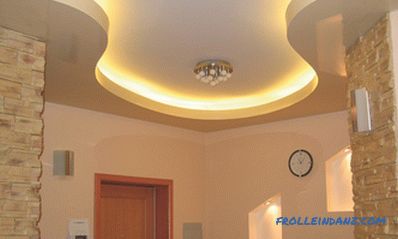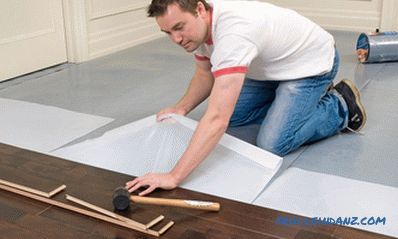Ceramic tiles have become an already familiar element in the interior design of kitchens, bathrooms and other rooms with high humidity. She is good to finish not only the walls, but also the floor. Laying tile - not too complicated process to call the wizard. All work can be done independently. It is only necessary to carry out some preparatory work and choose the right materials for repair. In this article we will talk about laying your own ceramic tile on the floor and walls, give step-by-step instructions, as well as video and photo materials.
Preliminary works
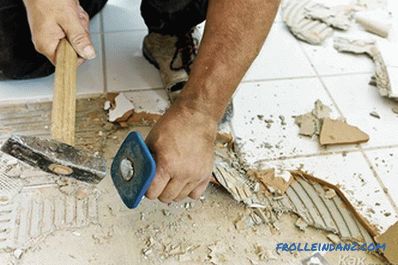 Dismantling the old tile
Dismantling the old tile
Before laying ceramic tile , it is necessary to clean the room.
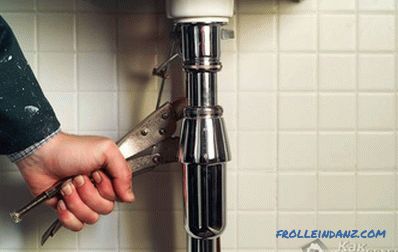 Preparation for repair in the bathroom
Preparation for repair in the bathroom
- All furniture is removed from the bathroom or kitchen.
- If you plan to finish the walls completely, then you should remove mirrors and other objects from them. Wash basin is also better to remove.
- After the room is freed from plumbing and mirrors, it is necessary to assess the scale of the work with the walls.
- If there is already an old tile on the walls, then you can take a chance and stick the tile directly on it. However, in this case, there is always a chance that the glue will not sustain the excess weight, and the repair will go down the drain. Better to dismantle the old tile.
- In order to remove the remains of an old tile, it is necessary to prepare a chisel. The tile gently breaks.
- After the surface is cleared of the tile, it is necessary to remove the remnants of old glue and other coatings from it.
- In order for the new tile to serve for a long time, the walls must be smooth and without deviations. The same applies to the floor, where you can also install tile. With the help of the level it is also necessary to determine the slope of the walls.
- If there is an unacceptable level of slope, the situation should be corrected with special mixtures. The mixture begins to be applied from the place where the greatest slope. The surface after treatment should dry out. That there were no problems with drying, it is necessary to lay the composition with a layer not exceeding 1.5 - 2 cm. In modern homes, the slope of the walls is usually not very large, so problems should not arise.
Choice of tile
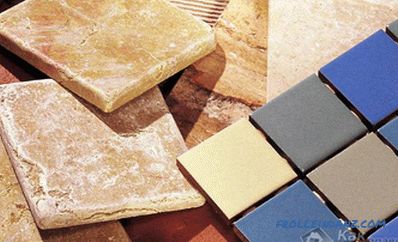 Choice of ceramic tile
Choice of ceramic tile
The tile is certain characteristics that distinguish one type of tile from another. Sometimes the owner after the purchase finds out that the tile that he has is not intended for the room where the repair is being made. Even if you install such a tile, it will very quickly lose its strength and initial properties. Therefore, laying ceramic tiles begins with the correct choice of material, which takes into account all the details.
 Types and types
Types and types
The following characteristics of tile are distinguished:
- Relief. This figure seems unimportant, but only at first glance. The relief of the tile, as well as the roughness of the surface can save from falling. If the tile is laid on the floor of the bathroom or in the bath, then it is better to choose the product not with a smooth surface, but with a relief.
- Shape, size, color, and patterns. The color and the presence of patterns will affect how harmoniously the tile will fit into the existing design of the room and the apartment as a whole. With the help of color, you can even visually change the size of the room or kitchen. When choosing a tile of a certain shape, it is necessary to take into account that small rooms need a tile of small format.
- Abrasion. The tile has 5 classes of abrasion, where the highest is the fifth. When choosing, do not focus on the most difficult to tiled products. It is better to ask the sales assistant, which tile is suitable for a particular case.
- In addition to abrasion, there is another important indicator - moisture absorption. The characteristic has 4 classes. When buying, you need to remember that for wet rooms requires a tile with the lowest level of moisture absorption. This applies to places such as the bathroom, bath and, in part, the kitchen.
On the floor
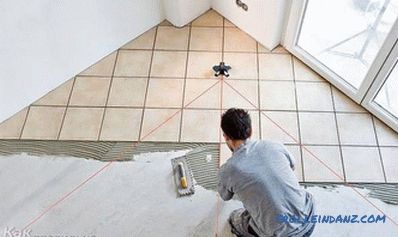 Laying the tile from an angle
Laying the tile from an angle
after the execution Preparatory work can proceed to the immediate installation of tiles. To work, you need to prepare the following tool:
- trowel;
- notched trowel;
- trowel;
- small (up to 40 cm) and medium ( up to 80 cm) level;
- plummet;
- rubber hammer;
- capacity for kneading glue;
- drill with nozzle on mixer;
- rubber gloves;
- tile cutter;
- Bulgarian with a circle on the granite;
- crosses to form a seam;
- wet rag;
- diamond-coated crown;
- pliers.
This set of tools is also necessary for laying ceramic tiles on the wall.
Laying tiles to dry
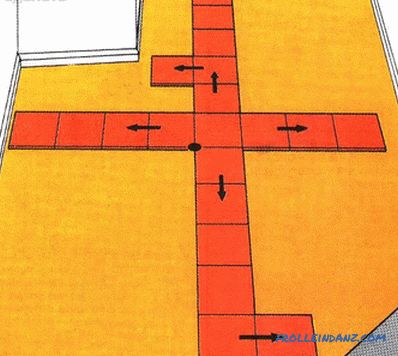 Laying on dry mix
Laying on dry mix
Before starting work it is necessary to make calculations. To do this, you need to perform a tile layout on the floor dry.If the room is small, then this layout will help to perform the trimming of most of the tiles. You can also trim near the pipe. Consider that the tile due to the layer of glue will rise, so cut a hole with a margin, on each side of 15-20 mm will be enough.
In order for the tile on the floor to look beautiful, think over the layout so that there is an identical piece of tile on both sides of the walls. After all, from the aesthetic side it will be ugly, if on one side the strip will have 5-8 cm, and on the other - 12-18. Although much depends on the size of the tile itself. Therefore, consider the most aesthetically consistent tile layout.
Some tilers trim the tiles along the laying. The probability of error is thus minimized. The above trimming method is applicable in cases where the room, for example, a bathroom, is small.
Laying technology
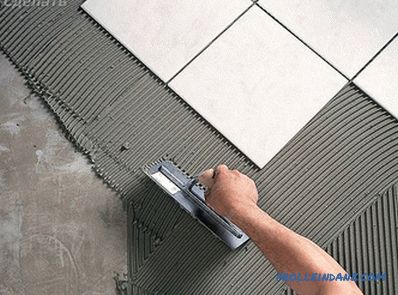
The sequence of laying tiles on the floor is as follows:
- First, make a small tile mix glue. In the finished mass should be no lumps. To prevent this, mix the glue thoroughly with a construction mixer.
- After this, apply the glue evenly with a notched trowel on a small area of the floor, for example, for 2 or 3 tiles.
- Before laying the tile, it is recommended to wipe its back side with a damp cloth. Dust impairs adhesion.
- You do not need to wet or wash ceramic tiles. It absorbs moisture poorly.
- Now you can apply glue to the back of the tile and also with a notched trowel.
- With the first 3 tiles laid out, peel them with crosses to form a smooth and neat seam.
- If one of the tiles protrudes, then lightly move it back and forth, drown it, or gently tap it with a rubber mallet.
- If the tile sags, then it should be torn off immediately and add glue to this place.
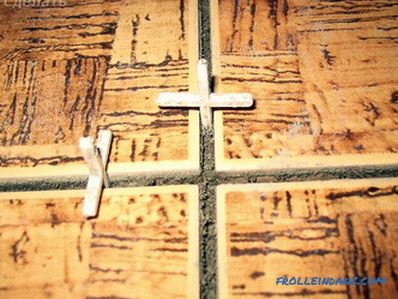 Seam formation
Seam formation
- Be sure to check the tiled tiles for leveling.
- If you need to wedge the tiles away from the wall, you can use all the same crosses or plastic / wooden wedges. To fix the tile is often used masking tape.
- When laying the second row, also check the level and do not forget to cross.
- In the process of laying tiles on the floor, glue will protrude from the seams. It must be removed with a damp sponge or rag. Also clean the seam of glue, for example, with a cross. It is easier to remove the glue when it is slightly grabbed.
- As you move, do not forget to check the level of each tile.
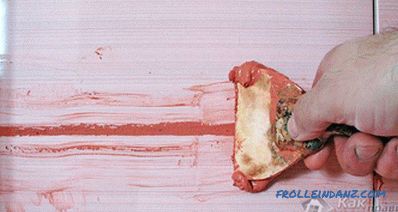 Grouting tile joints
Grouting tile joints
So, if you summarize the whole process of tile installation on the floor, then the scheme looks like this: glue is applied to the floor, then the back side of the tile is moistened, and then glue is also applied to it in a thin layer, then the tile is pressed to the floor and set on a level, and crosses are placed between the tiles to form a seam.
At first glance, everything may seem simple, but do not rush to conclusions. In this work, as in all others, there are many nuances. Especially the filigree work of installing small pieces of tile under the wall, in the corners and near the pipes. Here you need to cut out all the details with millimeter precision.
Tile Laying Methods
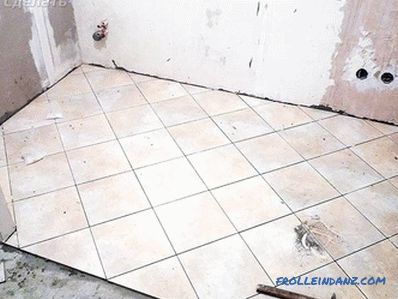
There are several ways to tile:
- Straight seam-to-seam rows.
- In pursuit. In this case, each subsequent row is shifted by half the tile of the previous one.
- Diagonally. This method is uneconomical (due to masonry many scraps will be formed). Its hardest to implement.
For beginners, it is recommended to stop at the first option - “seam to seam”. This technique is the simplest.
On the wall
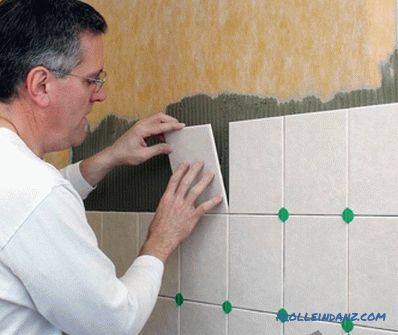 Laying on the wall
Laying on the wall
Technology of installing ceramic tiles on the walls different from laying it on the floor, but there are some similarities. For example, it is also necessary to determine in which direction the tile will be laid out: horizontally, vertically or diagonally. For example, if it is necessary to visually expand the room, then the tile is laid horizontally. If you need to increase the height of the room, then vertically.
Installation of the first row
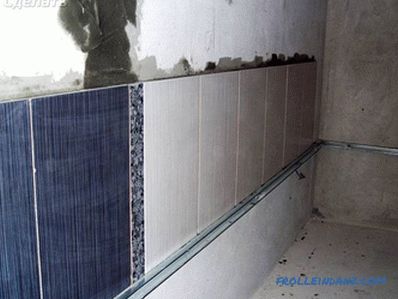
The first row of tile on the wall is not placed from the base of the floor, but at a height of 2 or 3 rows. Why? It is not always possible to achieve an ideal flatness of the floor, as a consequence, the first and subsequent series will be uneven. But even if the floor has a perfect horizontal, then often in the bathroom or toilet on the floor are sewer or water pipes. For this reason, it is necessary to start laying from the height of the second - third row. The work process looks like this:
- Using a water level, make a markup on the wall.
- Using the received line, you install a metal profile, which is usually used to make a drywall lath.
- It is very important to measure the height of the wall correctly. To do this, add the size of two tiles and note the required seam between them. Also calculate so that between the tiles that lie on the floor and the first row of wall tiles there is no large gap, ideally 2 rows of tiles should be placed without trimming.
- This also applies to the last row. If the entire height of the wall fails to lay out the rows without trimming, then decide where the tile will be trimmed at the bottom or top.
- If the guide rail is installed, you can proceed to gluing the tile.
- Apply glue to the wall, but not to a large area. Glue thickness up to 7 mm. Glue on the surface of the wall is distributed with a spatula with teeth.
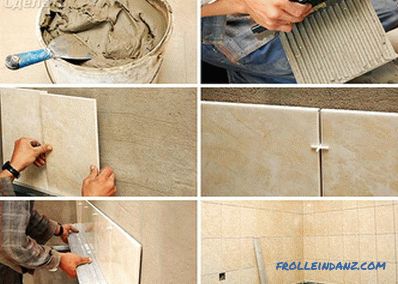 Laying sequence
Laying sequence
- The glue is also applied to the back side of the tile.
- After that, the tile is installed on the profile.
- It needs to be checked to the horizontal level. Each subsequent tile will be exactly on it.
- The tile should be pressed into the glue applied to the wall.
- All glue that has come out is removed.
- Be sure to place crosses between tiles. The width of the seam may be different.
- When you reach the corner, cut the tile to size.
An important nuance concerns the marking of tiles on the wall. Make the calculations so that the corners were trimming tiles of the same size. This will give the room a more aesthetic look. You can select the corner with a different color tile.
Installation of the second and subsequent rows
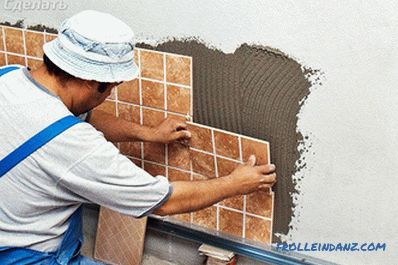
Each subsequent row is laid out in accordance with the first. There is also an important requirement for checking on the horizontal and vertical. If you have reached a place where there are outlets of water pipes for a mixer or a tap, then in a tile, cut a round hole with the help of a diamond-coated crown.
At the end of the work, it remains to grout the joints with a special mixture. If the tile is placed in the bathroom, then choose the grout specifically for wet areas. This will prevent mold on it.
On wooden floor
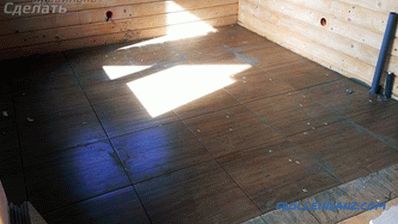
To the surprise of many, today ceramic tiles can also be laid on wooden floor. But to perform this work, it is necessary to make a number of preparatory work. As a rule, wooden floors are painted. For the task, it should be removed with the help of various chemical agents and special tools, for example, with a building dryer. Also, the surface of the wooden floor can be processed with a grinding machine. In addition, you should ensure the integrity of the lag and the coating itself. If there is damage, then separate sections of the flooring, as well as logs, should be replaced. Moisture-resistant drywall can be used as a tile substrate. He is screwed to the floor with screws. For the organization of ventilation, holes are drilled in the sheets. This is important, because due to the accumulation of moisture drywall can become a breeding ground for dampness and mold.
When the FCLV sheets are laid, take a mounting foam and insulate all the joints between the floor and the wall. After this coating must be treated with linseed oil. Immediately before laying the tiles, it is recommended to spread the paint net soaked in latex onto the floor. The next layer that will cover the grid will consist of a mixture of water, water glass and coarse sand. This will ensure good adhesion, and during operation the tile will be held securely on the floor. The further course of laying tiles on the floor is performed according to the technology described above.
Important Details
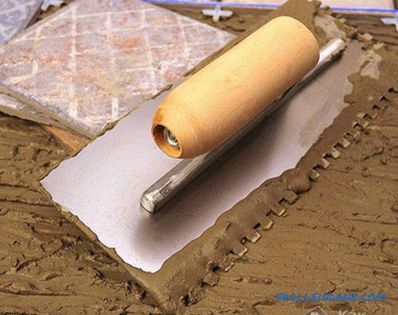 Spatula for styling
Spatula for styling
-
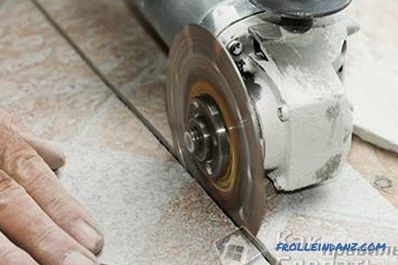 Cutting ceramic tiles Do not wet the tile before laying it on glue. This often causes one unpleasant effect: the tile begins to "float".
Cutting ceramic tiles Do not wet the tile before laying it on glue. This often causes one unpleasant effect: the tile begins to "float". - Tiled seams may not have strictly specified dimensions. They are determined individually.
- If there is old paint on the wall, then there may be a desire not to remove it completely, but to cut it on the surface. You should not do so, the coating must be completely removed. Otherwise, the tile will not last long.
- Working with dirty tools is strictly prohibited.
- The best way to cut tiles is to use a diamond wheel. This is one of the most accurate tools that allows you to cut tiles of the right size.
Where the beauty and appearance of the surface are not critical, you can use a cutter. But it is less accurate.
Video
The process of installing ceramic tiles is discussed in detail in the following video:
